Interplanetary Transport System – Booster
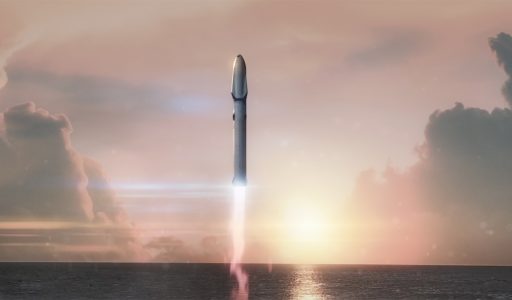
The Interplanetary Transport System Booster is one of three major hardware components of a complete architecture for the exploration and colonization of Mars, currently under development by SpaceX.
The system, formerly known as the Mars Colonial Transporter (MCT), fundamentally consists of a re-usable Booster, an Interplanetary Spaceship and a Tanker craft for in-orbit re-fueling. In the early stages of the project, the Booster system was referred to as BFR – Big F***ing Rocket, or Big Falcon Rocket.
Initial ideas for super-heavy-lift rockets based on the Falcon launch vehicle fleet were first discussed by SpaceX in 2010, but – by the time design work began in earnest in 2012 – the planned outline of the vehicle had changed fundamentally, stepping away from the Falcon but keeping a number of its technologies, especially in the re-use department pioneered by the Falcon 9.
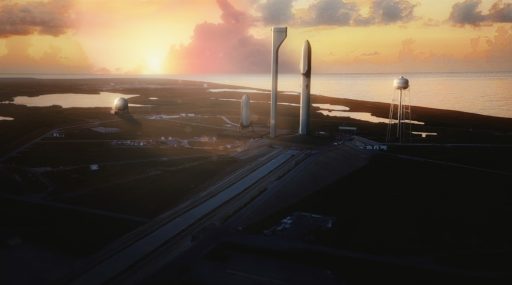
ITS is suitable for the exploration of destinations anywhere in the Solar System both robotically and with a crew on board. The overall system can be characterized as a Two-Stage-to-Orbit concept with the Spaceship doubling as the second stage of the launch vehicle and interplanetary transfer craft, requiring in-orbit refueling prior to departing Earth.
SpaceX CEO and Chief Designer Elon Musk revealed the complete ITS concept to the world in 2016 as a fully reusable architecture for shipping cargo and crews to Mars and returning humans safely to the Earth, ultimately at affordable prices and high reliability. Depending on funding for the project as well as technical challenges, SpaceX expects ITS could begin orbital test flights before the end of the decade with the first crew departing for Mars around 2024.
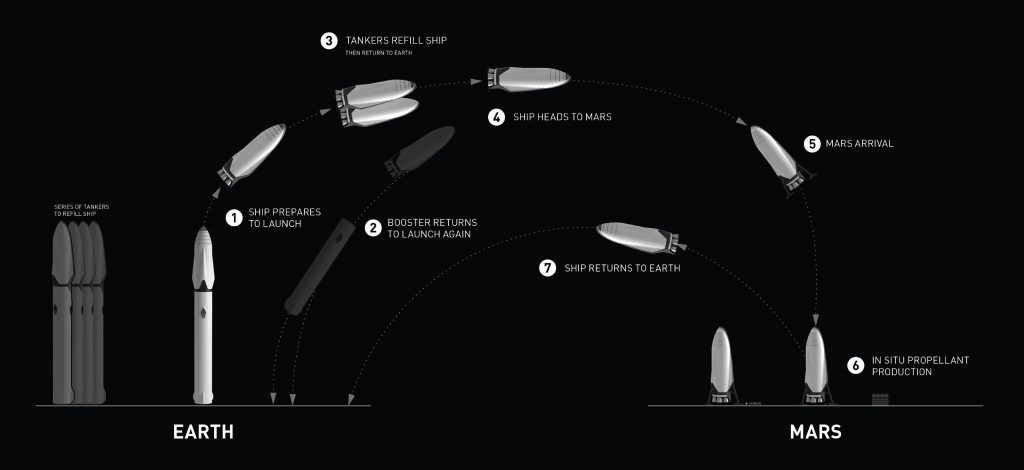
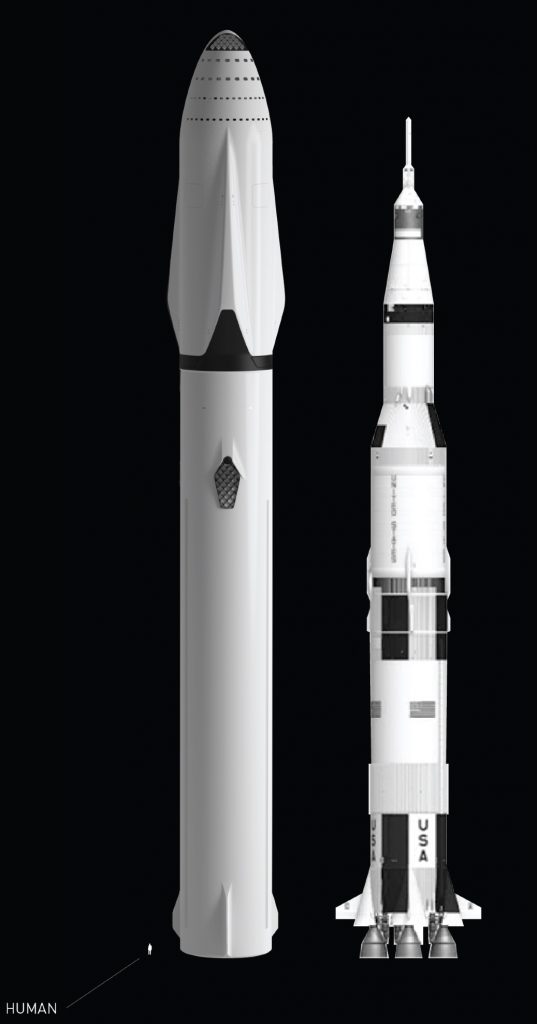
The stated goal during initial development work on the MCT was the delivery of 100 metric tons to the surface of Mars. However, SpaceX designed a much more powerful architecture that could send significant payloads well beyond Mars, necessitating a name change to ‘Interplanetary Transport System.’
The ITS launch vehicle stack is composed of two stages, flying in two variants – both employing the ITS Booster as a first stage while the second stage may be either the Interplanetary Spaceship flying in a crew or cargo configuration, or a Tanker.
Per the reusable architecture, the Booster is designed to fly 1,000 missions, completing a propulsive return to its launch site after dispatching the Spaceship / Tanker on their way towards Low Earth Orbit.
The integrated ITS stack stands 122 meters tall, making it the tallest rocket ever – surpassing the mighty Saturn V by 11 meters. Its launch mass of 10,500 metric tons trumps the Saturn V’s 3,040 metric tons by a factor of 3.5 and ICT outperforms the Saturn by a factor of 3.6 in terms of liftoff thrust.
Due to the use the more energetic Liquid Oxygen – Liquid Methane propellant combination, ITS can outperform the Saturn V by a factor of 4.1 on the mass delivered to Low Earth Orbit. In a fully expendable configuration, ITS can loft a LEO payload of 550 metric tons while the reusable booster can send 300 metric tons into orbit. ITS can lift ten times the payload of SpaceX’s Falcon Heavy rocket.
Booster Design

| Type | ITS Booster |
| Length | 77.5 m |
| Diameter | 12 m |
| Dry Mass | 275 t |
| Propellant Mass | 6,700 t |
| Oxidizer | Sub-Cooled Liquid Oxygen |
| Fuel | Sub-Cooled Liquid Methane |
| Oxidizer Mass (Est.) | 5,275 t |
| Fuel Mass (Est.) | 1,425 t |
| LOX Temp (Est.) | 66 K |
| LCH4 Temp (Est.) | 93 K |
| Oxidizer Volume (Est.) | 4,290 m³ |
| Fuel Volume (Est.) | 3,160 m³ |
| Propellant Fraction | 0.96 |
| Propulsion | 42 Raptor Sea Level |
| Total Thrust (SL) | 127,800 kN |
| Total Thrust (Vac) | 138,400 kN |
| Attitude Control | Gimbaling of 7 central Raptor Engines |
| Coast Control | Reaction Control Thrusters (O2 & CH4) |
| Atmospheric Flight | 3 Actuated Grid Fins |
| Tank Pressurization | Autogenous (Engine Tapoff) |
| Staging Velocity | 2,400 m/s |
| Propellant for Return | 470 t |
The ITS Booster stands 77.5 meters tall and is 12 meters in diameter with an inert mass of 275 metric tons, utilizing carbon-fiber components for its structural elements and propellant tanks.
In an original concept, MCT was expected to scale up the existing Aluminum-Lithium tanks of the Falcon 9 but SpaceX opted for a Carbon-fiber primary structure given its low-weight and high stability. Both tanks on the booster use a Stringer & Ring Frame structure for mechanical support. ITS makes use of the common concept of placing the oxidizer tank above the fuel tank, running the LOX feed line (over 1.5m in diameter) through the center of the Methane tank.
The selection of carbon-fiber material poses one large technological challenge which is to make the tank walls impermeable for the propellants, both in their liquid and gaseous phase and avoiding stress-cracking at the pressure levels needed for flight.
The LOX tank in the upper portion of the booster has two spherical bulkheads, sharing a common bulkhead with the LCH4 tank as has become standard practice to reduce dry mass and the overall length of the stage. The LCH4 tank appears to have a flat bottom facilitating a large manifold system for the distribution of oxidizer to the main propulsion system. The first stage holds 6,700 metric tons of propellants – approximately 5,300 metric tons of Liquid Methane and 1,400 metric tons of LOX.
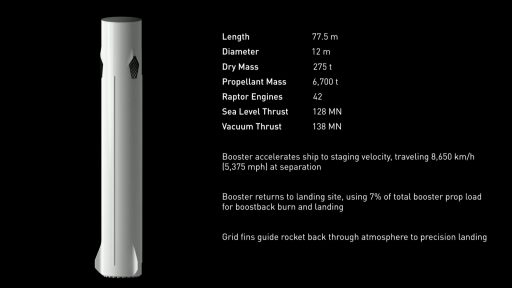
42 Raptor engines are installed on the base of the ITS Booster, each delivering a sea level thrust of 3,050 Kilonewtons at a specific impulse of 334 seconds, rising to a thrust of around 3,295kN in vacuum conditions. At full throttle, ITS has a liftoff thrust of 13,000 metric-ton-force which, with a launch mass of 10,500 tons, creates an initial thrust-to-weight ratio of 1.29.
The engines are arranged in two rings and an inner cluster with 21 engines installed in the outer ring, 14 in the inner ring and seven in the central cluster. Only the seven central engines are equipped with gimbaling systems for thrust vector control, the outer engines are fixed in position, eliminating the mass of 35 TVC assemblies.
>>SpaceX Raptor – Detailed Technical Overview
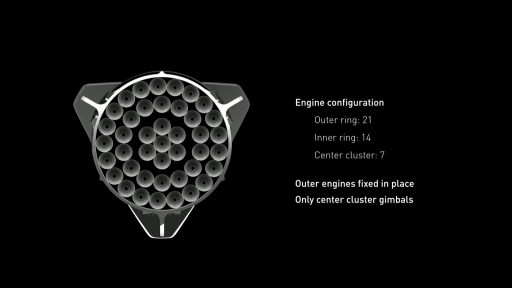
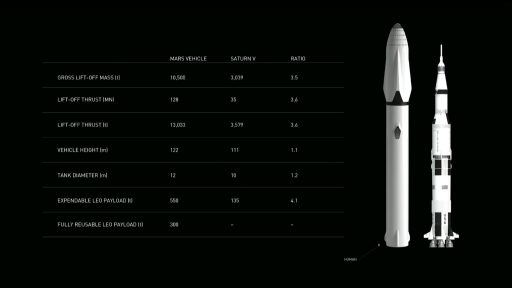
Unlike the Saturn V that used five powerful engines on its first stage, SpaceX is betting on 42 Raptor engines to operate in unison to get the vehicle into orbit – a design very much resembling the Soviet N1 moon rocket that clustered 30 engines and failed miserably during all of its test flights in the 1960s & 70s. SpaceX says the engine clustering is an advantage when combined with modern computers and control systems, giving the vehicle multi-engine out capability to guarantee its valuable payload reaches orbit.
Like the Merlin 1D series, Raptor can support extremely deep throttling with stable combustion possible down to 20% of the engine’s rated thrust. This enables the ITS Booster to fly flexible ascent profiles and actively throttle its engines on the way back to a propulsive landing, requiring active control of the vehicle’s thrust-to-weight ratio.
Tank pressurization on the ITS uses an autogenous system – self-pressurization from the Raptor engines. The Full-Flow Staged Combustion Cycle of the Raptor engine makes it easy to obtain pure oxidizer and fuel tapoff gases that can be routed through pressure regulators to keep the tanks at the proper flight pressure, cutting a Helium pressurization system which – as Falcon 9 has shown – can present a number of problems.
One peculiarity of the ITS Booster design is a large spherical tank installed in the lower portion of the methane tank. According to Elon Musk, ITS cuts the Nitrogen-fueled cold gas thrusters that Falcon uses for attitude control when coasting outside the atmosphere as well as propellant settling prior to re-lighting the main engines for the propulsive return. On ITS, the thruster system makes use of gaseous methane and oxygen and the spherical tank could be a pressurized sphere holding the gaseous methane for the thrusters when the engines are not actively delivering tapoff gas.
The ITS Stage Separation System appears to use a pusher system similar in architecture to the Falcon rockets.
Propellant Sub-Cooling
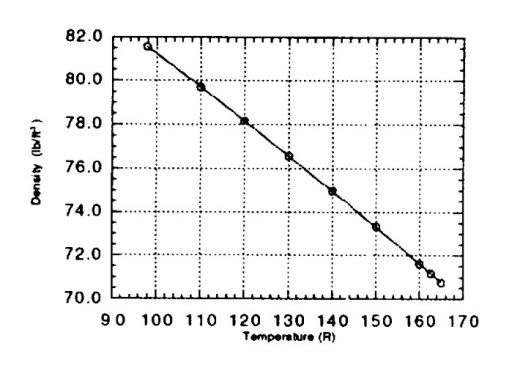
Analogous to SpaceX’s Falcon rockets, ITS will employ sub-cooled propellants with the sole motivation of densifying the supercold liquids in order to fit a greater mass of propellant into the limited tank volume of the launch vehicle.
Falcon (and most likely ITS as well) employs LOX at a temperature of approximately –207°C, about 10°C above the Oxygen Triple Point and 24°C below its boiling point – achieved by running the LOX through a Nitrogen bath that is kept at a partial vacuum to decrease its temperature to nearly N2 ice temperature. This will yield an increase in LOX density from 1.134 grams per cubic centimeter to nearly 1.23g/cm³ while still maintaining the LOX above its freezing point and slush density of 1.338g/cm³. Cooling the LOX to this temperature point yields a density increase of around 8%.
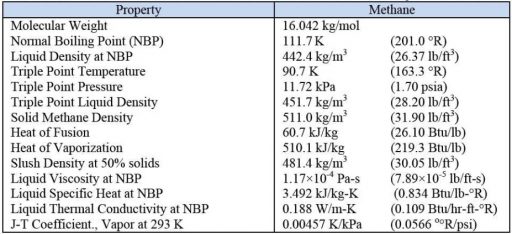
Densification for methane is possible as well and yields a similar increase on the order of 7%, of course depending on the temperature chosen by SpaceX which was not revealed at IAC 2016.
Methane exists in liquid form in a much narrower temperature range than LOX: it boils at -162°C and freezes at -182.5°C (ambient pressure). At its boiling point, methane has a density of 0.423g/cm³ increasing to 0.482g/cm³ at what its known as the Slush Point where half the methane exists in liquid form while the other half is already frozen.
Because frozen methane is very undesirable for propulsion, SpaceX is likely to select a temperature warmer than the methane triple point. A NASA study showed that methane at a temperature of -180.2°C maintains the fluid in a usable form for rocket engines with no ice particles, favorable viscosity, and a density of 0.451g/cm³.
However, it is possible that SpaceX would go for Slush Methane to achieve a further increase of density. This would require them to master unprecedented technology because viscous slush methane is much harder to pump and places the fuel boost- and turbopump under extreme stress.
Elon Musk stated the Raptor engines will operate at a mixture ratio of around 3.8, though tank sizes shown in technical drawings of the ITS Booster and Spaceship suggest a mixture ratio closer to 3.7. The propellant volumes shown in the table above are values calculated based on the given propellant mass and approximate densification yield & are therefore considered to be estimates.
ITS Booster Re-Use
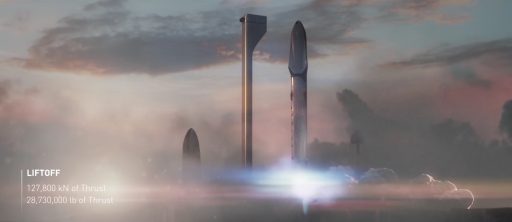
The Interplanetary Transport System is conceptualized to be fully reusable with 1,000 uses per Booster, 100 uses per Tanker and 12 round trips to Mars with one spacecraft over a period of over 25 years.
Re-use on the booster is accomplished similar to the Falcon 9 rocket – launching the vehicle to the edge of space and accelerating the second stage so it can reach orbit while keeping a propellant reserve in the tanks of the booster sufficient for a propulsive return to Earth. The ITS Booster is designed to accelerate the Interplanetary Spaceship to a velocity of 2.4 Kilometers per second, separating near the edge of space from where the Spaceship will fire its own Raptor engines to reach Low Earth Orbit.
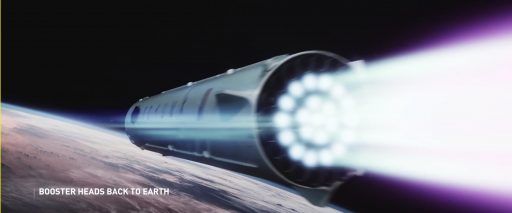
Following separation, the Booster uses its gas thrusters to pitch over and achieve a retrograde attitude in which it will quickly settle its propellants and fire up half its engines (all but the outer ring) to make a boost back maneuver aiming for its launch site. Next is another re-orientation to point the engines once again toward the direction of travel for a re-entry burn to slow the vehicle down when hitting the atmosphere, only firing the seven-engine cluster in the center.
Flying through the atmosphere, ITS employs three grid fins that can maneuver along two degrees of freedom to control the precise three-axis orientation of the booster – flying out any cross-track errors and controlling the downrange travel distance.
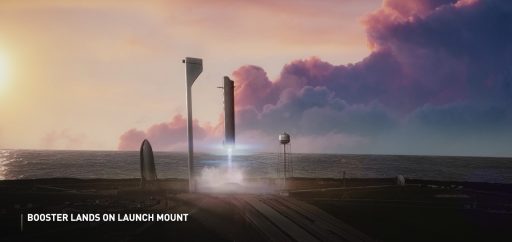
Where ITS takes it a step further than the Falcon 9 rockets is the precision of its landing. Falcon 9 has the luxury of a very large concrete landing pad allowing for quite some error in its final descent to the ground. ITS on the other hand has to maneuver back to its launch pad and precisely set itself down to be re-captured by the launch mount because the vehicle does not feature landing legs (a mass-saving measure).
A direct return to the launch pad will enable a rapid turnaround between flights. A SpaceX animation shows the vision of having a Tanker module stored close by to be installed atop the Booster within hours of its return to be refueled and re-launched in the shortest possible time to then link up with the Spaceship in orbit to begin the process of refueling for Mars.
Per the baseline design, ITS reserves 7% of its propellant mass for the boostback and landing maneuver, corresponding to 470 metric tons of LCH4 and LOX. Elon Musk stated the aim is to reduce the propellant reserve to 400 metric tons through fine tuning of the landing precision, reducing the margin available during final descent.
